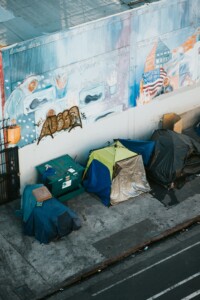The Face of Homelessness
I first became familiar with and learned about homelessness at my high school, a private Catholic high school located in Indianapolis, Indiana. Like many high schools, we had a requirement to complete community service hours. In addition, they encouraged us to help the least of these and to feed the hungry and take care of those living in poverty. Growing up, I did not see many homeless people in my neighborhood. However, my grandparents were very active in our community and in our church. Weekly, my grandfather would take groceries to people in need of food; some homeless others impoverished. Serving others is what we did as a family. Because of how normalized it was, I learned at an early age that the unseen are often those we need to reach. The unseen have a face; people experiencing homelessness don’t all look alike.
Common Misconceptions About People Experiencing Homelessness

- Someone can just go and get a job. Going to job interviews requires transportation. Transportation costs money. Many who are experiencing homelessness do not have a place to bathe, or they may not have clean clothes.
- They want to be homeless: Most of the people I’ve met do not want to be homeless. It is important for us to understand that after a person has lived on the streets for a length of time, a community is built. The people living near each other become friends and family. At a certain point, they grow accustomed to living outside or in shelters; it is their way of life. In addition, it is extremely hard to gain housing once it is lost.
- They are all addicts: Only some of the people experiencing homelessness are addicted to drugs. Some began to use drugs to cope with living on the streets.
- They are pretending: While there may be some people who pretend to be homeless and are really rich, these people do not comprise the majority of the population.
- They are criminals or have done something wrong: Many people assume that all people who live on the streets are dangerous criminals who are looking to hurt other people. While there are people who have committed crimes, most are not dangerous and looking to hurt people.
- They can get help if they want it: A lot of the resources available focus on emergency, temporary help. Things like not having ID, a permanent address or access to showers make it difficult to find employment, and hence, financial stability.
- Demographics: There is no one face of homelessness. This disgraceful problem crosses all demographic lines, including age, gender, race, ethnicity, religion . . .
Identifying Solutions
As communities and individuals, we must demand that our policymakers develop and implement policies that promote dignity and care of the unsheltered. We must also dedicate more financial resources to agencies and organizations, including grants. They need to be able to afford employing social workers and staff to work with those experiencing homelessness. It is also important that we make it a priority to spend some time with the unsheltered; the experience of sitting down and sharing a conversation helps us to see their humanity. We learn that we have many things in common with our unsheltered siblings. These interactions will serve as inspiration as we advocate on their behalf.

